Sculpting the endomembrane system in deep time: high resolution phylogenetics of Rab GTPases
- PMID: 22366452
- PMCID: PMC3383260
- DOI: 10.1242/jcs.101378
Sculpting the endomembrane system in deep time: high resolution phylogenetics of Rab GTPases
Abstract
The presence of a nucleus and other membrane-bounded intracellular compartments is the defining feature of eukaryotic cells. Endosymbiosis accounts for the origins of mitochondria and plastids, but the evolutionary ancestry of the remaining cellular compartments is incompletely documented. Resolving the evolutionary history of organelle-identity encoding proteins within the endomembrane system is a necessity for unravelling the origins and diversification of the endogenously derived organelles. Comparative genomics reveals events after the last eukaryotic common ancestor (LECA), but resolution of events prior to LECA, and a full account of the intracellular compartments present in LECA, has proved elusive. We have devised and exploited a new phylogenetic strategy to reconstruct the history of the Rab GTPases, a key family of endomembrane-specificity proteins. Strikingly, we infer a remarkably sophisticated organellar composition for LECA, which we predict possessed as many as 23 Rab GTPases. This repertoire is significantly greater than that present in many modern organisms and unexpectedly indicates a major role for secondary loss in the evolutionary diversification of the endomembrane system. We have identified two Rab paralogues of unknown function but wide distribution, and thus presumably ancient nature; RabTitan and RTW. Furthermore, we show that many Rab paralogues emerged relatively suddenly during early metazoan evolution, which is in stark contrast to the lack of significant Rab family expansions at the onset of most other major eukaryotic groups. Finally, we reconstruct higher-order ancestral clades of Rabs primarily linked with endocytic and exocytic process, suggesting the presence of primordial Rabs associated with the establishment of those pathways and giving the deepest glimpse to date into pre-LECA history of the endomembrane system.
Figures
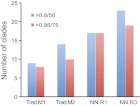
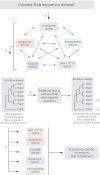
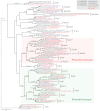
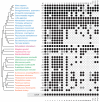
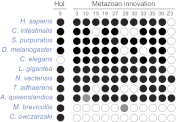

Similar articles
-
Are There Rab GTPases in Archaea?Mol Biol Evol. 2016 Jul;33(7):1833-42. doi: 10.1093/molbev/msw061. Epub 2016 Mar 31. Mol Biol Evol. 2016. PMID: 27034425 Free PMC article.
-
Untangling the evolution of Rab G proteins: implications of a comprehensive genomic analysis.BMC Biol. 2012 Aug 8;10:71. doi: 10.1186/1741-7007-10-71. BMC Biol. 2012. PMID: 22873208 Free PMC article.
-
Rab protein evolution and the history of the eukaryotic endomembrane system.Cell Mol Life Sci. 2010 Oct;67(20):3449-65. doi: 10.1007/s00018-010-0436-1. Epub 2010 Jun 26. Cell Mol Life Sci. 2010. PMID: 20582450 Free PMC article. Review.
-
Comprehensive analysis reveals dynamic and evolutionary plasticity of Rab GTPases and membrane traffic in Tetrahymena thermophila.PLoS Genet. 2010 Oct 14;6(10):e1001155. doi: 10.1371/journal.pgen.1001155. PLoS Genet. 2010. PMID: 20976245 Free PMC article.
-
An evolutionary perspective on eukaryotic membrane trafficking.Adv Exp Med Biol. 2007;607:73-83. doi: 10.1007/978-0-387-74021-8_6. Adv Exp Med Biol. 2007. PMID: 17977460 Review.
Cited by
-
Are There Rab GTPases in Archaea?Mol Biol Evol. 2016 Jul;33(7):1833-42. doi: 10.1093/molbev/msw061. Epub 2016 Mar 31. Mol Biol Evol. 2016. PMID: 27034425 Free PMC article.
-
An isoprenylation and palmitoylation motif promotes intraluminal vesicle delivery of proteins in cells from distant species.PLoS One. 2014 Sep 10;9(9):e107190. doi: 10.1371/journal.pone.0107190. eCollection 2014. PLoS One. 2014. PMID: 25207810 Free PMC article.
-
Systems cell biology.J Cell Biol. 2014 Sep 15;206(6):695-706. doi: 10.1083/jcb.201405027. J Cell Biol. 2014. PMID: 25225336 Free PMC article. Review.
-
Gene expression and cellular changes in injured myocardium of Ciona intestinalis.Front Cell Dev Biol. 2024 Mar 13;12:1304755. doi: 10.3389/fcell.2024.1304755. eCollection 2024. Front Cell Dev Biol. 2024. PMID: 38544819 Free PMC article.
-
Reconstructing the last common ancestor of all eukaryotes.PLoS Biol. 2024 Nov 25;22(11):e3002917. doi: 10.1371/journal.pbio.3002917. eCollection 2024 Nov. PLoS Biol. 2024. PMID: 39585925 Free PMC article. Review.
References
-
- Abascal F., Zardoya R., Posada D. (2005). ProtTest: selection of best-fit models of protein evolution. Bioinformatics 21, 2104-2105 - PubMed
-
- Adl S. M., Simpson A. G., Farmer M. A., Andersen R. A., Anderson O. R., Barta J. R., Bowser S. S., Brugerolle G., Fensome R. A., Fredericq S., et al. (2005). The new higher level classification of eukaryotes with emphasis on the taxonomy of protists. J. Eukaryot. Microbiol. 52, 399-451 - PubMed
-
- Ayong L., Pagnotti G., Tobon A. B., Chakrabarti D. (2007). Identification of Plasmodium falciparum family of SNAREs. Mol. Biochem. Parasitol. 152, 113-122 - PubMed
Publication types
MeSH terms
Substances
Grants and funding
LinkOut - more resources
Full Text Sources

